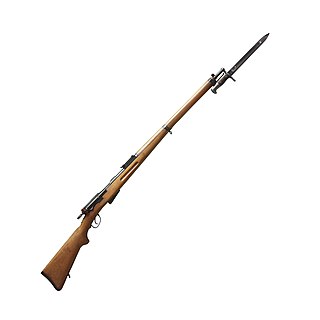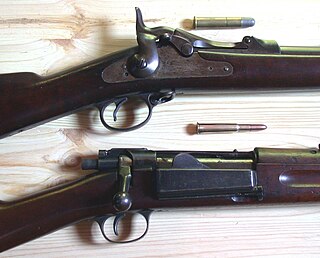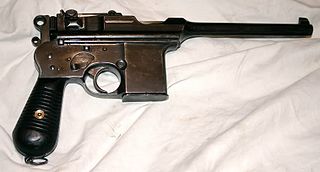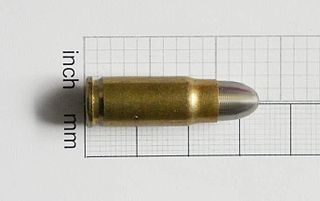
A carbine is a long gun that has a barrel shortened from its original length. Most modern carbines are rifles that are compact versions of a longer rifle or are rifles chambered for less powerful cartridges.

The Krag–Jørgensen is a repeating bolt-action rifle designed by the Norwegians Ole Herman Johannes Krag and Erik Jørgensen in the late 19th century. It was adopted as a standard arm by Norway, Denmark, and the United States. About 300 were delivered to Boer forces of the South African Republic.

A machine pistol is an autoloading pistol capable of fully automatic fire. The term can also be used to describe a stockless handgun-style submachine gun. The term is a calque of Maschinenpistole, the German word for submachine guns. Machine pistols were developed during World War I and originally issued to German artillery crews who needed a self-defense weapon that is lighter than a rifle but more powerful than a standard semi-automatic pistol. This concept would eventually lead to the development of the personal defense weapon or PDW. Today, machine pistols are considered special-purpose weapons with limited utility, with their original niche being filled with either the PDW, carbines, or simply more modern semi-automatic sidearms. Contributing to their already-fringe use, without a shoulder stock and training, machine pistols can be difficult to control for all but the best shooters.

Mauser, originally the Königlich Württembergische Gewehrfabrik, was a German arms manufacturer. Their line of bolt-action rifles and semi-automatic pistols was produced beginning in the 1870s for the German armed forces. In the late 19th and early 20th centuries, Mauser designs were also exported and licensed to many countries, which adopted them as military and civilian sporting firearms. The Gewehr 98 in particular was widely adopted and copied, and it is the foundation of many of today's sporting bolt-action rifles.

The Mauser C96 is a semi-automatic pistol that was originally produced by German arms manufacturer Mauser from 1896 to 1937. Unlicensed copies of the gun were also manufactured in Spain and China in the first half of the 20th century.

The Schmidt–Rubin rifles were a series of Swiss Army service rifles in use between 1889 and 1958. They are distinguished by the straight-pull bolt action invented by Rudolf Schmidt and use Eduard Rubin's 7.5×55mm Schmidt–Rubin rifle cartridge.

A magazine, or simply called mag, is an ammunition storage and feeding device for a repeating firearm, either integral within the gun or externally attached. The magazine functions by holding several cartridges within itself and sequentially pushing each one into a position where it may be readily loaded into the barrel chamber by the firearm's moving action. The detachable magazine is sometimes colloquially referred to as a "clip", although this is technically inaccurate since a clip is actually an accessory device used to help load ammunition into a magazine or cylinder.

The 7.62×25mm Tokarev cartridge is a Soviet rimless bottleneck pistol cartridge widely used in former Soviet states and in China, among other countries. The cartridge has since been replaced in most capacities by the 9×18mm Makarov in Russian service.

The M1901 Mannlicher Self-Loading, Semi-Automatic Pistol was an early semi-automatic pistol design. The Bundeswehr Museum of German Defense Technology in Koblenz has one of these specimen in its collection.

The MP 18 is a German submachine gun designed and manufactured by Bergmann Waffenfabrik. Introduced into service in 1918 by the German Army during World War I, the MP 18 was intended for use by the Sturmtruppen, assault groups specialized in trench combat, as a short-range offensive weapon that would provide individual soldiers with increased firepower over a pistol.

The Springfield Model 1892–99 Krag–Jørgensen rifle is a Norwegian-designed bolt-action rifle that was adopted in 1892 as the standard United States Army military longarm, chambered for U.S. caliber .30-40 Krag cartridges. All versions and variants were manufactured under license by the Springfield Armory between 1892 and 1903 and famously served as the longarm during the Spanish–American War.
The Mondragón rifle refers to one of two rifle designs developed by Mexican artillery officer General Manuel Mondragón. These designs include the straight-pull bolt-action M1893 and M1894 rifles, and Mexico's first self-loading rifle, the M1908 - the first of the designs to see combat use.

The Astra Model 900 is one of many Spanish copies of the German Mauser C96 semi-automatic pistol. It shares the same caliber, magazine capacity, and holster type and is generally very similar to the German handgun.

The 9×25mm Mauser is a cartridge developed for the Mauser C96 service pistol around 1904 by DWM. Mauser pistols in this relatively powerful caliber were primarily intended for export to Africa, Asia, and South America. The 9mm Mauser Export cartridge was produced specifically for Mauser pistols and carbines made from 1904 to 1914 and then later from approximately 1930 to 1945 for submachine guns chambered for this caliber.
The Norinco Type 80 is a close-combat machine pistol that was used in China in the 1980s by the People's Liberation Army of China. It was developed by Norinco in the 1970s, influenced by the design of the German M712 Schnellfeuer.

The Roth–Steyr M1907, or, more accurately Roth-Krnka M.7 was a semi-automatic pistol issued to the Austro-Hungarian kaiserliche und königliche Armee cavalry during World War I. It was the first adoption of a semi-automatic service pistol by the army of a major military power.
The Mauser Model 1893 is a bolt-action rifle commonly referred to as the Spanish Mauser, though the model was adopted by other countries in other calibers, most notably the Ottoman Empire. The M1893 was based on the experimental M1892 rifle, which Paul Mauser developed for the Spanish Army as part of a program to correct deficiencies in the earlier 1889, 1890, and 1891 series of Mauser rifles. The M1893 introduced a short staggered-column box magazine that fit flush with the bottom of the stock; the magazine held five smokeless 7×57mm Mauser rounds, which could be reloaded quickly by pushing a stripper clip from the top of the open bolt.

The 7.63×25mm Mauser round was the original cartridge for the Mauser C96 service pistol. This cartridge headspaces on the shoulder of the case. It later served as the basis for the 7.62mm Tokarev cartridge commonly used in Soviet and Eastern Bloc weapons.

The Modelo 1905 is a pistol designed by Ferdinand Ritter von Mannlicher in 1899 and originally produced in Austria as the Mannlicher Model 1901. The Mannlicher Model 1901 was an improved version of the Model 1900, both of which were produced by Österreichische Waffenfabriks-Gesellschaft. All of these models have the same basic design and operation, but minimal adjustments were made to improve each of them. The Modelo 1905 is the version of the Model 1901 that the Argentine Army purchased from Steyr in 1905. This semi-automatic pistol has a unique and elegant appearance due to the curve of the handgrip. It is single action and uses a blowback operation system to reload. Like its predecessors, the Modelo 1905 has a non-detachable magazine that can be loaded from the top with a stripper clip.

















